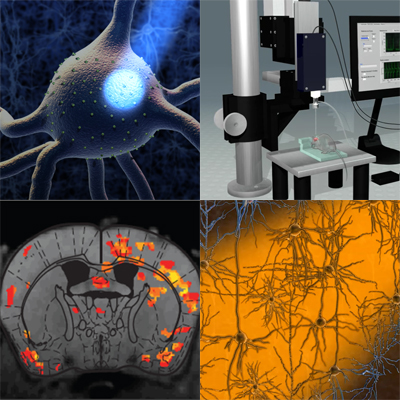Principles of Neuroengineering
[Class Content] [Fall 2018] [Fall 2017] [Fall 2015] [Fall 2014] [Fall 2013] [Fall 2012] [Fall 2011] [Fall 2010] [Fall 2009] [Fall 2008] [Fall 2007]

MIT Course Numbers: 9.422 ~ 20.352/20.452 ~ MAS.881
Instructor: E.S. Boyden
Teaching assistant:S.L. Johnson
Units: 3-0-9 Units
Time: Tuesdays and Thursdays, 10:30AM-12PM
Place: E14-493
Description
Covers how to innovate technologies for brain analysis and engineering, for accelerating the basic understanding of the brain, and leading to new therapeutic insight and inventions. Focuses on using physical, chemical and biological principles to understand technology design criteria governing ability to observe and alter brain structure and function. Topics include optogenetics, noninvasive brain imaging and stimulation, nanotechnologies, stem cells and tissue engineering, and advanced molecular and structural imaging technologies. Includes design projects. Designed for students with engineering maturity who are ready for design. Students taking graduate version complete additional assignments.Schedule
Part I. Towards ground-truth understanding of the brain. Knowns (principles, building blocks, functions) and unknowns.
9/5, Overview of the class. The nature of principles of neuroengineering. Examples. Introductions.9/10, Circuit elements of the nervous system. Neurons, glia. Channels, receptors, transmitters. Genes, cell types. Modalities of signaling (ionic, gap junctional, synaptic/chemical, second messenger, diffusible, etc.). New mechanisms (brain-immune, microbiome, etc.).
9/12, Principles of designing tools. Thinking backwards, tiling trees, constructive failures, debugging vs. designing, top-down vs. bottom-up design approaches, roadmapping, architecting, tools for science vs. for the clinic, ease of use, assumption-proofing.
9/17, How to find primary literature and what to beware
9/19, Macroscopic circuit principles. Brain regions and connectivity, large-scale dynamics. How these past conclusions were influenced by past technologies, and what is unknown or uncertain.
9/24, Form teams (if you want) and brainstorm designs
9/26, Example paper discussion and break into groups for student led paper discussions in October
10/1, Microscopic circuit principles. Cell type-specific connectivity, connectomics, gliocircuits. Synapses, structure-function relationships. How these past conclusions were influenced by past technologies, and what is unknown or uncertain.
10/3, Student-led paper discussions
10/8, Student-led paper discussions
10/10, Student-led paper discussions then design project status update
10/17, No recitation/class
Part II. Technologies for mapping and measurement: molecular, anatomical, and dynamical observation and readout.
10/24, Large-scale mapping and measurement. PET, photoacoustic imaging, MEG, EEG, fMRI, infrared imaging, ultrasound imaging, and more. Overcoming scattering of light. Physical principles of large-scale brain interfacing.10/29, Fine-scale mapping and measurement. Electrodes, nanoprobes, genetically encoded fluorescent indicators, ticker-tapes, barcoding, optical imaging and light microscopy, electron microscopy, expansion microscopy.
10/31, Midsemester checkin presentations.
Part III. Technologies for controlling and constructing: molecular, anatomical, and dynamical control and building.
11/5, Review topics covered in lecture thus far11/7, Discuss feedback on midsemester checkin presentations
11/12, Large-scale control. Magnetic, electrical, ultrasonic, pharmacological/pharmacogenetic, thermal, interferometric, and more.
11/14, Fine-scale control. Infrared optical stimulation, optogenetics, nanoparticle-mediated control, uncaging, signaling control.
11/19, Examine sample(s) of past design projects
11/21, Circuit building. Development, 3-D brain building, tissue engineering, stem cells, organoids, gene therapy and viral/trangenic technologies, extracellular matrix.
11/26, MIT Center for Neurobiological Engineering annual neurotechnology conference (eight guest speakers from around the world; runs all day).
12/3, Building blocks of future tools. Quantum-measurement nanoparticles, DNA origami, exosomes, prions, post-transcriptional/translational modifications, and more.
Part IV. Conclusion.
12/5, Final project presentations.12/10, Final project presentations.